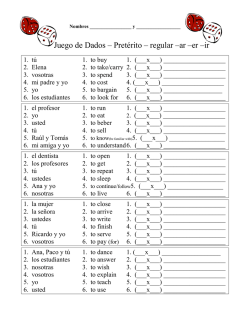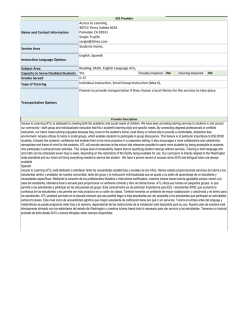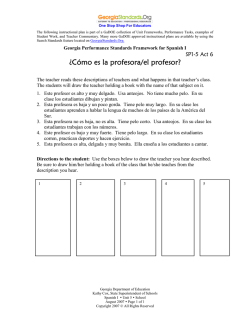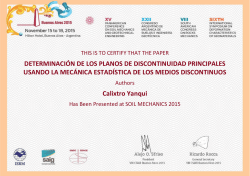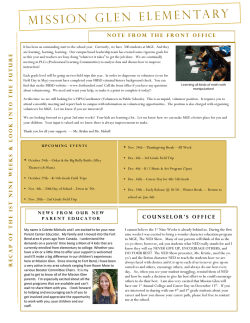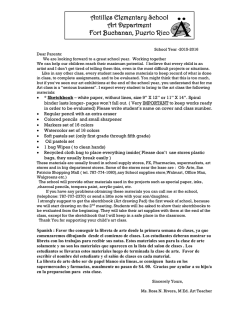
Presentation Materials
Effective Instructional Strategies for Elementary Students from Underserved Populations Dr. J. Joy Esquierdo, University of Texas Rio Grande Valley Reflection Every child, regardless of the disguise, knows what he or she is not. We must teach every child what he or she can be. -Author Unknown Objectives Participants will Understand the characteristics of gifted Hispanic bilingual/ESL students. Gain strategies to differentiate curriculum to provide Hispanic bilingual/ESL students with an appropriate level of challenge through project-based learning. Outline 1. 2. 3. What are some characteristics of giftedness in a bilingual child? How do these characteristics differ from the mainstream student? How can I provide services to the Hispanic gifted student(s) in the bilingual/ESL/regular classroom? Activity With a partner, make a list of the typical gifted characteristics. Think about what you look for when screening/nominating for giftedness in your classroom. Think about previous workshops that described giftedness. Hispanic Bilingual Gifted Characteristics The Hispanic Bilingual Gifted Screening Instrument (HBGSI) (Irby & LaraAlecio, 1996) Resulted from two comprehensive studies and extensive review of literature Purpose: Determine if further testing for GT service is needed Hispanic Bilingual Gifted Characteristics HBGSI’s 11 Clusters Motivation for learning Social & Academic learning Cultural sensitivity Familial Collaboration Imagery Achievement Creative performance Support Problem solving Locus of control 11 Clusters of Gifted Bilingual 11 clusters GT Bil Motivation for Learning Students demonstrate a value for education through good school attendance. They exhibit a desire for learning, are persistent, and have a sustained motivation to succeed in school. Social and Academic Language Bilingual/GT students not only like to read, speak, listen, and write in their native language, but they also achieve well in those areas. They are expressive, elaborate, and fluent in verbal behaviors. Cultural Sensitivity They appear to have pride in their language/culture, respect for traditional cultural and linguistic patterns and a value for oral tradition and history of the native culture. They also appreciate other cultures. Familial The students exhibit a “Caretaker” personality within the family. The strong family and adult relationships and respect for authority figures that are exhibited among this population may be perceived as non-gifted trait, since gifted identification scales tend to equate nonconformity toward authority and independent thought with superior abilities. Collaboration The students have ability to lead and work in groups. Good at setting goals. Keen sense of justice. Judge events and people. Good social adjustment. Possesses leadership qualities. Participates in school activities. Imagery They tend to exhibit language rich imagery and appear to be imaginative in storytelling. Achievement They have the ability to use stored knowledge to solve problems. They have the ability to generalize learning to other areas and to show relationships among apparently unrelated ideas. Talents are demonstrated through various projects and interests at home or in the community. Performs at or above grade level, more so in math. Creative Performance Students have attributes that deal with creative productivity in the arts. They are perceived to be creative in lyric production to songs with more creativity exhibited in groups. They also prefer alternative assessments to standardized assessments. This means that teachers need to use multiple assessments and evaluation tools. Support It is important to note that simply because teachers and administrators perceive students to be gifted, does not negate the fact that they are in need of support. The children tend to respond favorably and perform better when the teachers expressed confidence in their abilities. Teachers need to support their area of interest, but enrich their academic environment. Problem-solving Students are more likely to be global learners who complete tasks in a patient, non-hurried manner, yet effective and accurate. They perform better on spatial fluency tasks as opposed to verbal fluency tasks, and they exhibit high nonverbal fluency and originality. Locus of Control Bil/GT students tend to have an internal locus on control. Individual believe that his/her behavior is guided by his/her personal decisions and efforts. However, many times these students have a keen sense of observation of expectations from society and desire to meet those expectations (external locus of control). Other Important Characteristics Learn better through social interaction than through isolation, Tend to be more cooperative than competitive, Reason in a step-by-step process rather than spontaneous. www.teachbilingual.com Activity With a partner discuss the difference between the characteristics of mainstream GT children and Hispanic Bilingual GT children. GT: Mainstream vs Bilingual Learning through Project-based Learning Learning is a social activity; it takes place within the context of culture, community and past experiences. Buck Institute, 2003 Learning takes place in contexts where students are given the opportunity to actively discover, construct, and transform knowledge. Johnson & Johnson, 2006 24 Group Activity At your table discuss and provide examples of: What do students need to discover new content and vocabulary? How can students construct new knowledge? What can be evidence that students have transformed information to form new knowledge? 25 Project-based Learning An exploration of a philosophical question – “What is a healthy community?” An investigation of a historical event or a natural phenomenon. A problem-solving situation – either real or fictitious. An in-depth examination of a controversial issue. A challenge to design an artifact, plan or event. A challenge to create a piece of writing, multimedia or work of art for a particular audience or purpose. From: Jacque Melin’s Website www.formativedifferentiated.com Project-based Learning A classic project-based learning activity usually involves 4 basic elements: (1) an extended time frame; can be from 2-6 weeks (2) collaboration; (3) inquiry, investigation, and research; and finally, (4) the construction of an artifact or performance of a consequential task. Within this basic framework, students and teachers can adapt activities to showcase and assess understanding. 27 Funds of Knowledge Gonzalez, Moll, and Amanti (2013) define funds of knowledge as historically accumulated and culturally developed bodies of knowledge and skills essential for household or individual functioning and well-being. What is your community’s Funds of Knowledge? FoK 1 FoK2 My Community FoK3 FoK4 What is the Funds of Knowledge of Your Family? Steps to Follow 1. 2. 3. 4. 5. 6. Begin with the end in mind. Select the standards, topics from the curriculum. Design the driving question. Plan the assessment. Outline the project. Manage the process. Begin with the end in mind Create an objective that encompasses the higher order skills the students will be developing. Guide how the project will develop without micromanagement. Written Media Presentation Training Products Constructio n Products Tech Product s Research Report Podcast Speech Program Physical Model Computer Database Narrative Essay Graphic Novel Debate Manual Machine Website Proposal Slide Show Play Model Scientific Instrument Brief Oral History Song Proposal Museum Exhibit Poem Drawing Lyrics Estimate Diorama Poster Blog Musical Piece Bid Movie Script Oral Report Blueprint Outline Dramatic Reenactment Flow Chart Brochure Panel Discussion Time-line Survey Newscast Questionnaire Skit Autobiography Discussion Essay Dance Book Review Proposal Report Data Display Editorial Product Exhibition App Select the standards, topics from the curriculum Learning needs to be meaningful relevant. Differentiation is critical and can occur within the standards. Keep in mind that the standards are the floor, not the ceiling. Bring in the funds of knowledge. Funds of Knowledge in Projectbased Learning Think about one lesson you can create based on your community’s funds of knowledge. Content area: Skill(s) to be learned: How will it be learned: Funds of knowledge: Resources: Objective Format Students will __(HOT verb)__ the __(content area)__ by __(skills to be learned)__ in the context of __(funds of knowledge)__ using __(resources)__. TEKS as a guide Science 4.6 Force, motion, and energy. The student knows that energy exists in many forms and can be observed in cycles, patterns, and systems. The student is expected to: (A) differentiate among forms of energy, including mechanical, sound, electrical, light, and heat/thermal; (B) differentiate between conductors and insulators; (C) demonstrate that electricity travels in a closed path, creating an electrical circuit, and explore an electromagnetic field; and (D) design an experiment to test the effect of force on an object such as a push or a pull, gravity, friction, or magnetism. Design the driving question Help students think of the topic/content area in a broader way. Most questions can start with “Why is it important…?” “How can ___ have an impact on my community?” Forming a Driving Question Form open-ended questions that engage the students’ interests and abilities. How? First, list key unit themes, then for each add a good question that will motivate students to explore that theme. It is crucial that the introductory lessons for any new topic capture students’ interests and motivate them to actively learn the material. 39 ELA Driving Question and Entry Event Healthy Choices = Long Life Driving Question: Why is it important to establish habits that promote a healthy lifestyle? Entry Event: You have been asked to From: Jacque Melin’s Website www.formativedifferentia ted.com present a media presentation at the next PTA meeting concerning what you feel is the most important health issue at your school (the PTA might fund a solution). You will need to research the health issue and be prepared to show evidence to the PTA of why this health issue is so important. You will need to describe the relationship between nutrition and health risk factors, analyze a disease prevention plan, and give strategies of how to change an unhealthy behavior. Plan the assessment Begin by knowing what you want the students to achieve and how you want students to get there. Consider that learning is a multidimensional activity; including knowledge and abilities as well as values, attitudes, and habits of the mind. Think of learning in the larger context of the educational community that includes the funds of knowledge. 41 Plan the assessment Assessment of whether goals have been attained and learning has occurred should have a clearly stated purpose, one related to the learning. Needs to focus on comparing educational goals and expectations with performance. Assessment should be ongoing rather than occurring only at the end Types: Peer to peer (internal) Peer to peer (external) Teacher to group Copyright © 2013-Dual Language Training Institute. All Rights 42 Knowledge Gained Graphics: Originality Graphics: Relevanc e Labels Content Accuracy 43 http://rubistar.4teachers.org Proyecto Investigativo-Planificación en Grupo : Cadenas alimenticias y la red alimentaria Nombre del maestro/a: Nombre del estudiante: ________________________________________ 2 1 Ideas/Preguntas Investigativas CATEGORY 4 Los investigadores identifican Los investigadores identifican por lo menos 4 por lo menos 4 ideas/preguntas ideas/preguntas razonables, razonables a seguir cuando perspicaces y creativas a hacen la investigación. seguir cuando hacen la investigación. 3 Los investigadores identifican, con la ayuda de un adulto, por lo menos 4 ideas/preguntas razonables a seguir cuando hacen la investigación. Los investigadores identifican, con bastante ayuda de un adulto, 4 ideas/preguntas razonables a seguir cuando hacen la investigación. Plazo de Tiempo del Grupo El grupo desarrolla un plazo de tiempo razonable y completo describiendo cuándo las diferentes partes del trabajo (por ejemplo, planeación, investigación, primer borrador, borrador final) estarían terminadas. Todos los estudiantes en el grupo pueden describir el plazo de tiempo usado. El grupo desarrolla un plazo de tiempo que describe cuándo la mayoria de las partes estarían terminadas. Todos los estudiantes en el grupo pueden describir el plazo de tiempo usado. El grupo desarrolla un plazo de tiempo que describe cuándo la mayoría de las partes estarían terminadas. La mayoría de los estudiantes en el grupo pueden describir el plazo de tiempo usado. El grupo necesita la ayuda de un adulto para desarrollar un plazo de tiempo y/o varios estudiantes en el grupo no saben qué plazo de tiempo fue usado. Delegación de Responsabilidad Cada estudiante en el grupo puede explicar que información es necesaria para el grupo y qué información él o ella es responsable de localizar y cuándo es necesaria. Cada estudiante en el grupo puede explicar qué información él o ella es responsable de localizar. Cada estudiante en el grupo Uno o mas estudiantes en el grupo no puede, con la ayuda de sus pueden explicar que informacion ellos compañeros, explicar son responsables de localizar. quéinformación él o ella es responsable de localizar. Plan para la Organización de la Información Los estudiantes tienen Los estudiantes tienen desarrollado un plan claro desarrollado un plan claro para para organizar la información organizar la información al final conforme ésta va siendo de la investigación. Todos los reunida. Todos los estudiantes pueden explicar estudiantes pueden explicar este plan. el plan de organización de los descubrimientos investigados. Los estudiantes tienen Los estudiantes no tienen un plan desarrollado un plan claro claro para organizar la información y/o para organizar la los estudiantes no pueden explicar su información conforme ésta plan. va siendo reunida. Todos los estudiantes pueden explicar la mayor parte de este plan. Calidad de las Fuentes Los investigadores identifican Los investigadores identifican por lo menos 2 fuentes por lo menos 2 fuentes confiables e interesantes de confiables de información para información para cada una cada una de sus ideas o de sus ideas o preguntas. Los investigadores, con ayuda de un adulto, identifican por lo menos 2 fuentes confiables de información para cada una de sus ideas o preguntas. preguntas. Los investigadores, con bastante ayuda de un adulto, identifican por lo menos 2 fuentes confiables de información para cada una de sus ideas o preguntas. Outline the project What should the whole project look like? Analyzing instructional needs, select activities, estimate time, and prepare resources. Scaffold: (videos, checklists, samples, graphic organizers, models, timelines, goal setting, etc..) Manage the process The the teacher’s role is of a facilitator When managing the process make sure to: Let students know the goals of the project Group students appropriately Clarify a timeline Monitor and regulate Evaluate the success of the project and help student recognize what has been learned 46 Create a timeline Determine how much time will be needed for the project. Lay out the specific daily tasks. Number of days for the project may depend on the curriculum and the theme/topic. Timeline will help pace the development of the project and avoid projects that will not fully develop. Day 1 Day 2 Day 3 Day 4 Day 5 Day 7 Day 8 Day 9 Day 10 Driving Question Day 6 Present project Managing the Process http://ddih.wikispaces.com/PBL+-+The+Project+Wall 48 PBL for Bilingual Gifted Students Be sure to consider the unique characteristics of Gifted Bilingual Students. Infuse the funds of knowledge into the projects. Make learning fun, culturally-relevant, and critical.
© Copyright 2025
